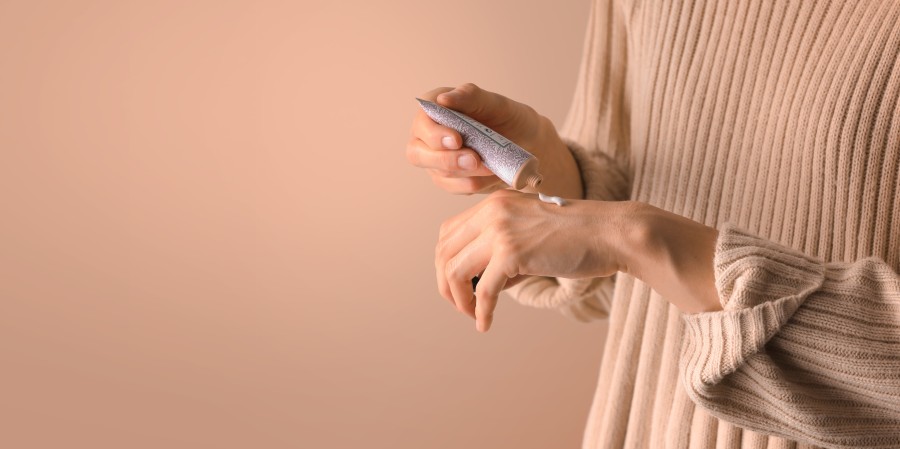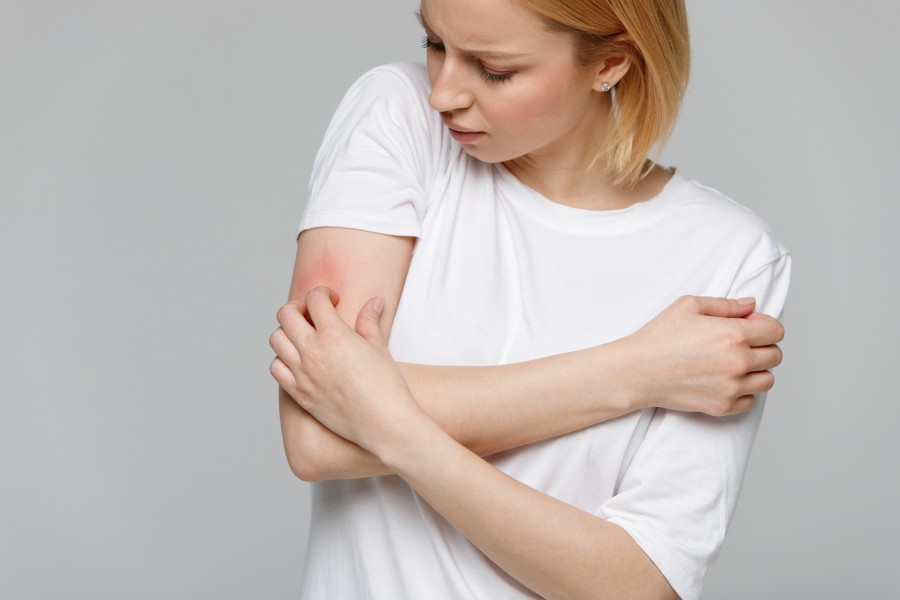Treating Dry Skin caused by Diabetes

Treating Dry Skin caused by Diabetes
Dry skin is a common issue for many people living with diabetes.1,2 Over time, high blood glucose levels can contribute to dry skin, calluses and skin cracks, which risk of more serious problems like foot ulcers.1
That’s why taking good care of your skin is so important if you have diabetes. In this article, we’ll cover some of the most common skin problems people with diabetes experience and share helpful tips for treating and preventing dry skin.
Dry skin, rashes and calluses
Some of the most common skin issues experienced by people with diabetes include:2–4
- Rashes and itchiness – these can be a result of bacterial or fungal infections (which are more likely when you have diabetes), skin disorders caused by high blood glucose, or other diabetes-specific problems such as nerve damage or reduced sweating.2,3
- Dry skin (also called xerosis) – one of the most common skin problems in people with diabetes, which can cause itching.2
- Calluses, fissures and skin cracks – these can happen as a result of peripheral artery disease or nerve damage and lead to further complications, such as foot ulcers.1,4
Diabetes rashes
Some of the rashes that you can develop as a result of diabetes include:2,3
- Fungal infections with Candida albicans – these cause itchy red rashes and small blisters and scales. Candida skin infections tend to occur in the folds of the skin, where the environment is warm and moist (under the breasts, between fingers and toes or in the armpits and groin).3
- Disseminated granuloma annulare – a condition that causes ring-shaped bumpy areas and plaques on the skin.2,3 These areas can be reddish in colour or skin coloured.3 Their outer edges are usually purple-red, and the centre is paler.2
- Eruptive xanthomatosis – a condition that causes reddish-yellow, pea-sized bumps on the skin.2,3 There are usually no other symptoms, but the bumps may sometimes be itchy.2,3
- Lichen planus – an itchy rash that causes purple bumps on the skin with whitish, shiny streaks on the surface.2
How to manage dry skin on your legs caused by diabetes
Dry skin can occur anywhere on your body. But, to relieve dry skin and itching on your legs specifically, try the following:3
- Opt for mild and/or moisturising soap when you bathe, and apply moisturising cream after bathing.
- Apply moisturiser rather than scratching your skin, as scratching can make your skin more vulnerable to infections. Moisturiser is all the more important in cold weather, as the skin gets drier then.
- Avoid very hot baths or showers, as these can increase skin itching and dryness.
- Limit how frequently you bathe, if possible, especially in winter months or if you tend to bathe very often.
How to manage dry skin on your feet caused by diabetes
Applying moisturiser is very important for managing dry skin when you have diabetes. But, there are special precautions you need to take for your feet specifically and some conditions you need to be
Fungal nail infections
Diabetes makes you more prone to fungal infections that can affect your skin and nails.2 To prevent them, you can follow these tips:
- Avoid applying moisturiser between your toes, as moisture can encourage fungus to grow.3
- After you bathe, make sure you dry properly, especially between the toes.5
- Keep your nails trimmed and make sure you cut them properly (straight across, not around) to avoid the risk of them growing into your skin or contributing to an infection.5
- Make sure you practise good foot hygiene and wear clean socks.5
See your healthcare professional if you notice your nails have thickened, turned yellow or grown inwards.2,5
Calluses
You should inspect your feet daily for any corns, calluses or blisters as part of your regular diabetes management.3
If you notice any calluses, don’t try to treat them yourself and see a healthcare professional instead.5 Avoid using chemical agents, plasters or anything else to remove calluses or corns, as this may worsen them and cause ulcerations.5
Blisters
Blisters can also lead to foot ulcers, so it’s important to see a healthcare professional if you see any blisters on your feet.5 Your doctor will explain how to protect the blisters or they’ll help drain them if necessary.5
Some people with diabetes may also develop blisters on their fingers, hands, legs or forearms.3 Usually, blisters heal on their own within a few weeks.3
Preventing diabetes dry skin issues

Preventing diabetes dry skin issues
Managing your diabetes and keeping your blood glucose in range can go a long way in preventing dry skin and other common skin problems, like rashes caused by infections.3 In addition, you can try following these tips:
- To prevent your skin from getting rough, dry and predisposed to cracks, moisturise it daily, especially in cold or windy weather.3
- During cold weather, when the air is drier, use a humidifier to keep the air in your home more humid.3
- In hot months, avoid excessive sun exposure, as this can worsen dry skin.4
- Keep your skin clean and dry it well after bathing to prevent infections.3
Treating dry skin
Keeping your blood glucose in range is one of the best ways to prevent and treat dry skin.3
You should also moisturise daily as part of your skincare routine and make sure you practise good skin hygiene.3
If you develop a rash, your healthcare professional may be able to recommend a topical treatment.2 However, many of the diabetes-related skin conditions go away on their own once you manage your blood glucose levels.3
When should you see a medical professional about your skin?
Speak to a medical professional if you develop any of the conditions highlighted in this article and cannot manage them yourself, or if you’re worried about your skin.3 Never try to treat corns or calluses yourself.5
Always see a medical professional if you’ve developed blisters, cuts, scratches, ingrown nails or an ulcer on your feet.5
Sources:
- Ericsson A, Borgström K, Kumlien (fd Wann-Hansson) C, et al. Treatment effects of two pharmaceutical skin care creams for xerotic feet among persons with diabetes: rationale and design of a two-armed double-blind randomized controlled trial. Contemp Clin Trials Commun. 2024;42:101372. https://www.sciencedirect.com/science/article/pii/S2451865424001194?via%3Dihub
- Vâță D, Stanciu DE, Temelie-Olinici D, et al. Cutaneous manifestations associated with diabetes mellitus-a retrospective study. Diseases. 2023;11(3):106. https://doi.org/10.3390/diseases11030106
- ADA. Diabetes and skin complications. Accessed 28 September 2024. Available at: https://diabetes.org/about-diabetes/complications/skin-complications
- Stingeni L, Tramontana M, Cordera L, et al. Xerosis in patients with type 2 diabetes: an Italian multicentre study. Acta Derm Venereol. 2021;101(10):adv00577. https://doi.org/10.2340/actadv.v101.263
- The International Working Group on the Diabetic Foot. IWGDF Guidelines on the prevention and management of diabetic foot disease. Accessed 28 September 2024. Available at: https://iwgdfguidelines.org/wp-content/uploads/2019/05/IWGDF-Guidelines-2019.pdf


